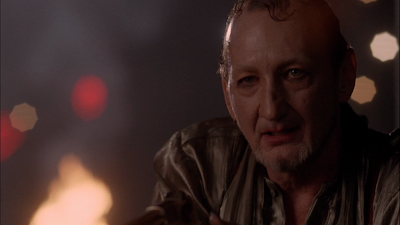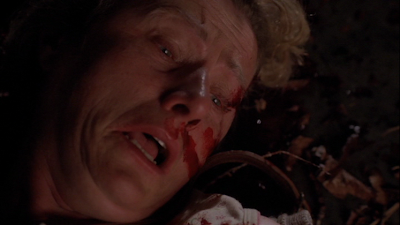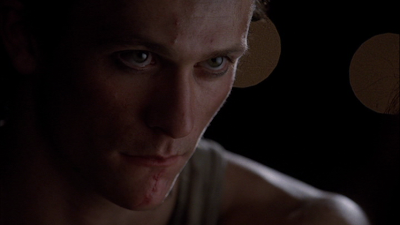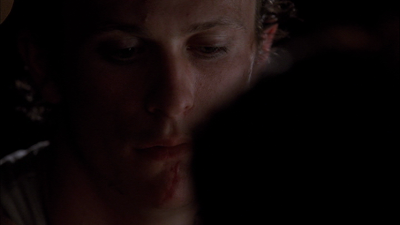Indeed, it is the piece out of all his aughts-era work to be proud of, as it sports a serious story with serious emotions, in augment to his serious aesthetics.
In spite of its numerous and formidable irritations, it is another work of aesthetic wholeness and singularity added to his catalog, one in which Hooper seems to have grabbed hold the opportunity to work fast and unpretentiously, of course, though, in the effort to create aesthetically and poignantly.
"Dance of the Dead" is a heavily and slickly graphic visual piece - which is more Fincher/Mereilles/Scott brothers than Hooper, if you follow my line of thought. But such concept- or "look"-driven visual inspiration coming upon Hooper, it is an episode he wanted to feel like a dream, and to jitter and daze feverishly like one suffocating in the polluted atmosphere of the blighted future it has dreamed up.
If it does not equal his other work in subtleties and rhetoric, it's then perhaps the most conventionally dramatic work Hooper had been offered in years. With that, Hooper delivers something unpretentiously gorgeous and emotive: saturated in dreamy photography and pathos-soaked close frames, he supports vivid and conventional melodrama - an impetuousness-of-youth Sturm und Drang and portrait of family implosion that builds to wretched heights not at his disposal since Spontaneous Combustion's sacrificing love story.
Without reference to the ultimate success of such choices, Hooper wanted it gritty, hallucinogenic, and fast-edited, and fast-edited it is, while DP Jon Joffin comes to his aid with his hazy, extremes-of-exposure lighting, neon source lights, and lush shallow focus that had them filming turgid close-ups from yards away.
Images from the finale of 'Dance of the Dead' *
* not a completely accurate depiction of the scene; while largely chronological and often looking at continuities and active shots, this is not at all close to being a beat-by-beat account; these are just "images from the finale"
* not a completely accurate depiction of the scene; while largely chronological and often looking at continuities and active shots, this is not at all close to being a beat-by-beat account; these are just "images from the finale"
Dusky, ashen background
Only the panicked youth in a sandwiched, middle focal field are crisp and blooded.
"Not much. She's dead. In a freezer all day."


Below, an adamantly uncompromising shot: one of ultimate degrading, of a person's literal sullying.
Struck ignominiously across the face, she falls splayed on the slick and dirty ground.
Absolutely no flattery of the camera for the mother revealed to be respondent to attitudes of lowliness and self-centeredness.
Struck ignominiously across the face, she falls splayed on the slick and dirty ground.
Absolutely no flattery of the camera for the mother revealed to be respondent to attitudes of lowliness and self-centeredness.
"Mom here decided just to leave her to me, no fuss, no muss."
"And as I recall, she was still alive."
"How much did I pay you for her? I forget."

Hooper even, very distastefully, depicts the mother getting punched in the face a second time, after letting her roar at the camera in all the ugliness of it.





The economy of the repetitive angles (the tight close-ups, the low-angles, the high-angles, etc.) -- not only professional in their unity, but in their simplicity and their insistence they create the material system (the economy) of the scene's spatial and emotional triangulations. Simplicity, but in service of fastidiousness. Notice how he lets his dreamy close-ups carry only the evocation of the eyeline (Art of the exquisite eyeline match).
In all the ugliness of it.








"I can make it right."


The film ends with a riptide of shots pulling into, out from, and generally across Peggy in her new incarnation. It is a visual compendium and an emotional one, one that takes in the veracity of her new life and her calcified emotion through the several roving, invasive shots. We explicitly end with a push-in that slides past the faceless Jak (who in kissing her neck - being totally and completely devoted to her - wipes out his face), and up to an inquisitively off-center* close-up of Peggy and her regard for what she watches in front of her.
* the framing is off-center for the reason of the camera being animate, conscious, inquisitive, i.e. wanting to cut the boy off just that much


















































































































2 comments:
http://www.youtube.com/watch?v=anofd6Ebvoo
http://www.youtube.com/watch?v=LUqbnYz_DsU
:)
Amazing.
[Video: 'Haunted Lives: True Ghost Stories' episode 1, an hour-long trilogy of ghost stories directed by Tobe Hooper]
[Video: Temps X Cinema: Mad Max 3 & Lifeforce, a French episodic Behind-the-Scenes show] [An interview with Hooper about halfway through has him describe 'Lifeforce' as "partly about the genesis of mankind" and holding of "spiritual overtones"]
Post a Comment